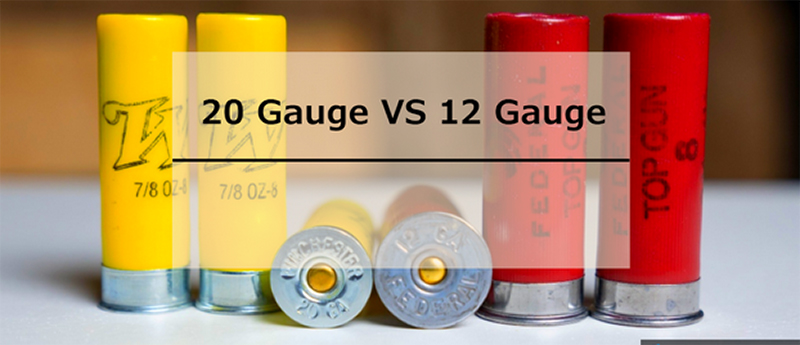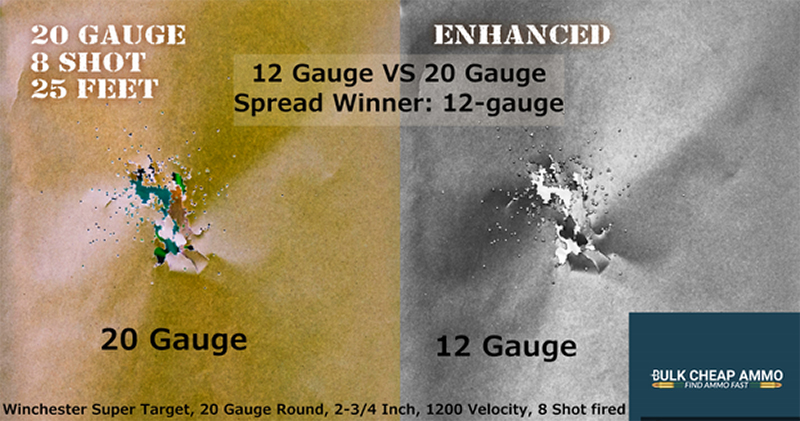12 Gauge And 20 Gauge Ammo Comparison.
All You Need to Know About 12 Gauge vs 20 Gauge.
The 12 Gauge and 20 Gauge are the most popular hunting and home defense choices. While they may appear similar, there are several key differences between these two types of shotgun ammo.

Understanding the differences between 12 Gauge and 20 Gauge can help you choose the right shotgun ammo for your needs.
Whether you're a seasoned shooter or a beginner, this guide will provide the information you need to decide which shotgun ammo is right for you. So, let's take a closer look at the differences between 12 Gauge ammo and 20 Gauge ammo.
12 Gauge vs 20 Gauge: Quick Overview
12 Gauge and 20 Gauge ammo both are types of shotgun ammunition. The Gauge refers to the diameter of the shotgun bore and the size of the ammunition that fits inside it. A 12-Gauge shotgun has a bore diameter of .729 inches, while a 20-Gauge shotgun has a bore diameter of .615 inches.
| 12 Gauge Ammo | 20 Guage Ammo |
|---|---|
| It is a popular and widely used shotgun ammunition. | It is a smaller shotgun ammunition compared to 12 Gauge ammo. |
| It has a larger diameter than 20 Gauge ammo and is typically used for hunting and self-defense purposes. | It is often preferred by beginners, youth, and smaller-framed shooters because of its lower recoil. |
| It is available in a variety of loads, from birdshot to buckshot and slugs. | It is suitable for small game hunting and shooting sports like skeet and trap. |
| It produces significant recoil, which can be challenging for some shooters, especially beginners. | It is available in a variety of loads, but the selection is not as vast as 12 Gauge ammo. |
12 Gauge vs 20 Gauge: Ballistics
When it comes to the ballistics of 12 Gauge ammo and 20 Gauge ammo, there are some differences to consider. There are many online ballistic calculators tools that will be helpful to calculat the ammo ballistic. Generally speaking, 12 Gauge ammo is larger and more powerful than 20 Gauge ammo.
- Recoil: Because 12 Gauge ammo is larger and more powerful, it typically has more recoil than 20 Gauge ammo. This can make it harder to shoot accurately, especially for smaller or less experienced shooters.
- Shot size: Both 12 Gauge and 20 Gauge ammo come in a range of shot sizes, but 12 Gauge ammo typically has larger shot sizes. This can be an advantage when hunting larger game or shooting at longer distances.
- Velocity: 12 Gauge ammo typically has a higher velocity than 20 Gauge ammo, meaning it travels faster. This can affect accuracy and range.
| Gauge | Load Type | Bullet Weight | Muzzle Velocity | Muzzle Energy |
|---|---|---|---|---|
| 12 | Birdshot | 1 oz | 1290 fps | 1745 ft-lbs |
| 20 | Birdshot | 7/8 oz | 1210 fps | 1202 ft-lbs |
| 12 | Birdshot | 00 Buck | 1325 fps | 1648 ft-lbs |
| 20 | Birdshot | 3 Buck | 1200 fps | 1014 ft-lbs |
| 12 | Slug | 1 oz | 1600 fps | 2704 ft-lbs |
| 20 | Slug | 3/4 oz | 1600 fps | 2040 ft-lbs |
12 Gauge vs. 20 Gauge: Range and Spread
12 Gauge and 20 Gauge ammo are both shotgun cartridges that have their unique range and spread patterns. The 12 Gauge is larger and more powerful than the 20 Gauge, and as a result, it has a longer range and a wider spread.

The range of a shotgun cartridge refers to the distance the pellets can travel and still have enough energy to cause damage. The 12 Gauge has a longer range than the 20 Gauge due to its larger size and higher power. The 12 Gauge can typically reach distances of up to 50 yards, while the 20 Gauge has a maximum effective range of around 40 yards.
The spread of a shotgun cartridge refers to the pattern that the pellets create when fired. The 12 Gauge has a wider spread than the 20 Gauge due to its larger size and more powerful blast. The 12 Gauge will typically have a spread of around 30 inches at a distance of 20 yards, while the 20 Gauge will have a spread of around 20 inches at the same distance.
12 Gauge vs 20 Gauge: Weight and Size
In terms of weight and size, 12 Gauge ammunition is generally heavier and larger than 20 Gauge ammunition due to the larger diameter of the shot. For example, a typical 12 Gauge shell may weigh around 1.5 ounces and measure about 2.75 inches in length, while a typical 20 Gauge shell may weigh around 7/8 of an ounce and measure about 2.5 inches in length.
| Gauge | Shotshell Length | Shot Charge (oz) | Total Weight (oz) | Total Weight (g) |
|---|---|---|---|---|
| 12 | 2 3/4" | 1 1/8 | 1.5 | 42.5 |
| 12 | 2 3/4" | 1 1/4 | 1.625 | 46.0 |
| 12 | 2 3/4" | 1 3/8 | 1.75 | 49.6 |
| 12 | 3" | 1 1/8 | 1.6875 | 47.8 |
| 12 | 3" | 1 1/4 | 1.8125 | 51.4 |
| 12 | 3" | 1 3/8 | 1.9375 | 54.9 |
| 20 | 2 3/4" | 7/8 | 0.875 | 24.8 |
| 20 | 2 3/4" | 1 | 1 | 28.3 |
| 20 | 2 3/4" | 1 1/8 | 1.125 | 31.8 |
| 20 | 3" | 7/8 | 1.0625 | 30.1 |
| 20 | 3" | 1 | 1.1875 | 33.7 |
| 20 | 3" | 1 1/8 | 1.3125 | 37.2 |
However, it is important to note that there are variations in weight and size depending on the specific type of ammunition and the manufacturer. Additionally, the ammunition's weight and size may not significantly impact the shotgun's performance, as other factors such as the velocity and type of shot may be more important.
12 Gauge vs 20 Gauge: Shootability Stopping Power
Shootability refers to how comfortable and easy it is to shoot a particular Gauge of ammunition. Generally, 20 Gauge ammo is considered to be more shootable than 12 Gauge ammo. This is because 20 Gauge ammo has less recoil than 12 Gauge ammo, making it more manageable and less fatiguing to shoot, especially for beginners or smaller-framed individuals.
On the other hand, stopping power refers to the ability of ammunition to incapacitate or stop a target. In general, 12 Gauge ammo is considered to have greater stopping power than 20 Gauge ammo due to its larger shot size and higher velocity. This makes it popular for hunting, self-defense, and law enforcement applications where stopping power is critical.
However, it is important to note that the effectiveness of any ammunition will depend on a variety of factors, including the target, range, and shot placement. Ultimately, the choice between 12 Gauge and 20 Gauge ammo will depend on individual preferences, shooting experience, and the intended use of the ammunition.
12 Gauge vs 20 Gauge: Applications
12 Gauge and 20 Gauge are popular shotgun calibers used for various applications. Here are some common uses for each:
12 Gauge Ammo
- Suitable for a wide range of applications, including hunting, home defense, and sport shooting.
- Typically used for larger game, such as deer or turkey, as well as for shooting clay targets.
- Offers a wider variety of loads, from light birdshot to heavy slugs, making it adaptable for different situations.
20 Gauge Ammo
- Good choice for smaller game, such as upland birds and small game animals
- Ideal for youth or smaller-framed shooters due to its reduced recoil
- Often used for sport shooting, such as skeet or trap shooting
- Not as powerful as 12 Gauge ammo, so it may not be as effective for home defense or larger game hunting
12 Gauge vs 20 Gauge: Ammunition Availability
12 Gauge shotguns have a wider variety of ammunition than 20 Gauge shotguns. This includes different shot sizes, types of shot, and slug ammunition.
Conclusion
When it comes to shooting, the main difference between 12 Gauge and 20 Gauge shotguns is the shell's size and the shot's power. A 12 Gauge shotgun has a giant shell and delivers more power than a 20 Gauge shotgun. However, a 20 Gauge shotgun is generally lighter and easier to handle than a 12 Gauge, making it a better choice for smaller-framed shooters. Ultimately, your best choice will depend on your shooting style and preferences.

